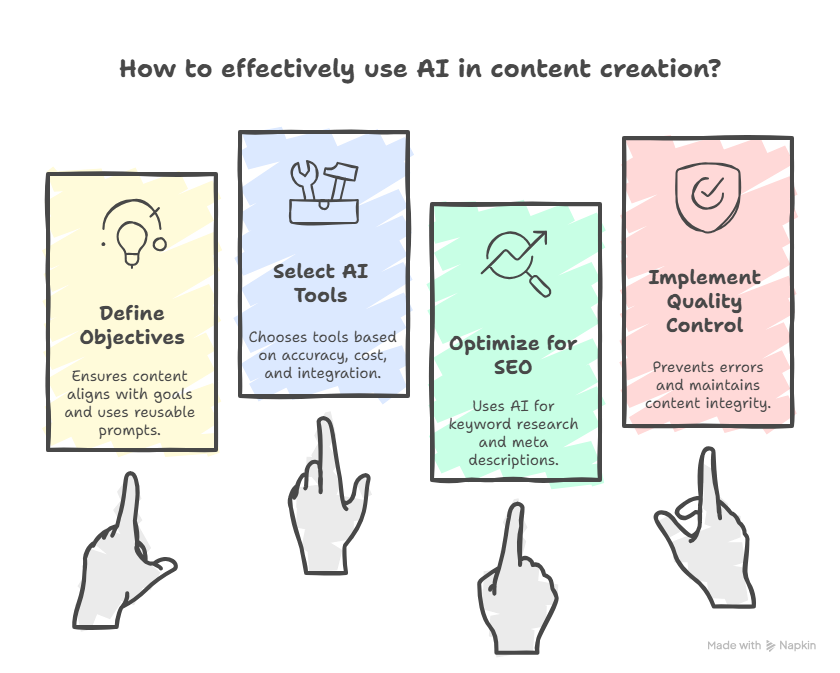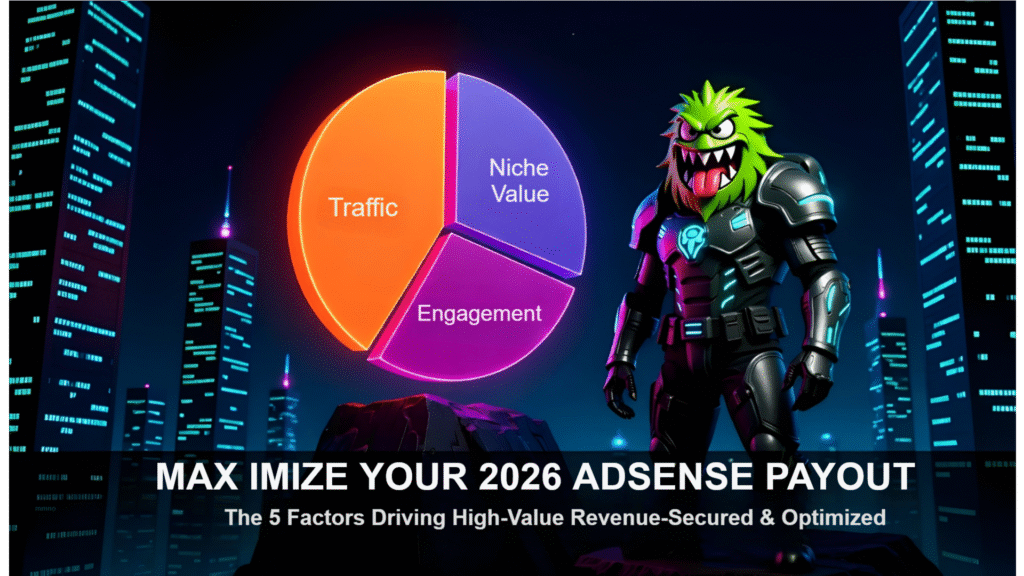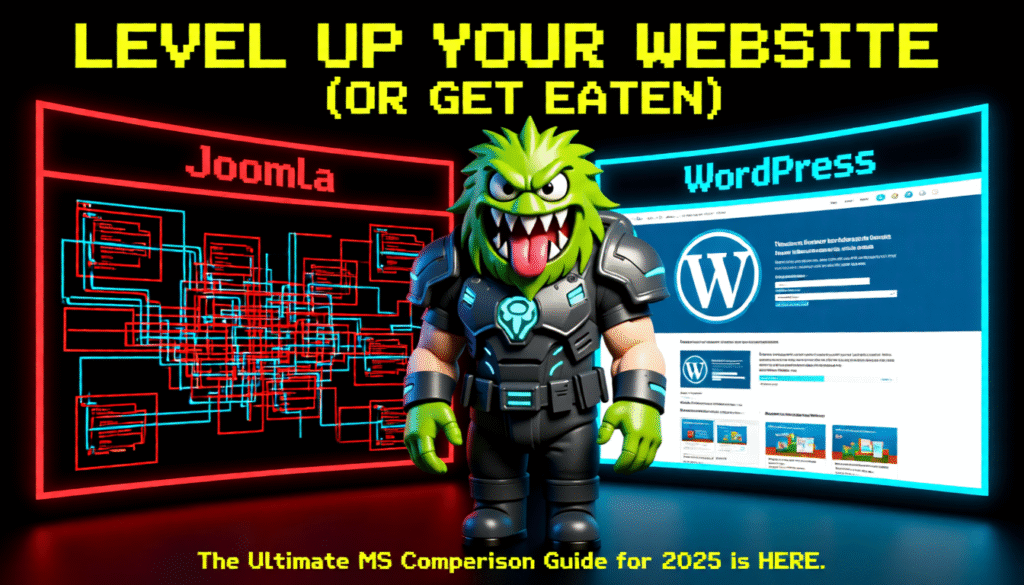This comprehensive guide details a practical, step-by-step AI content workflow designed for high quality and scale. It teaches you how to leverage AI tools for ideation and first drafts while mandating rigorous human oversight for fact-checking, brand voice consistency, and ethics. Key areas covered include:
-
Defining clear content objectives and using reusable prompt templates.
-
Selecting the right AI tools based on accuracy, cost, and integration.
-
Optimizing content for SEO using AI for keyword research, title tags, and meta descriptions.
-
Implementing strict quality control and editing checks to prevent hallucinations and factual errors.
By treating AI as a collaborator, you can cut drafting time by 50–70% and scale your content production without sacrificing editorial standards.
Key Takeaways:
- Define objectives, audience, tone, and SEO guidelines up front and use clear, reusable prompts and templates.
- Use AI to draft and ideate, then edit for accuracy, brand voice, and factual consistency before publishing.
- Build a workflow and choose tools for creation, optimization, and repurposing; measure performance and refine prompts.

Understanding AI in Content Creation Workflow
AI combines large language models for text and generative models for images/video to automate ideation, drafting, and optimization across blogs, social posts, ads, and video scripts. You can ramp output quickly—teams often report 50–70% faster first drafts—while retaining control through templates, editorial checklists, and versioning. Watch for hallucinations and quality drift; integrate fact-checking and human review into your workflow so speed doesn’t erode accuracy.
What is AI Content Creation?
AI Content Workflow creation uses models like GPT for prose and diffusion/transformer models for visuals to generate headlines, outlines, drafts, image assets, and metadata. You prompt tools to produce SEO-focused articles, microcopy for ads, or multiple social captions, then refine outputs. In practice, you combine prompt engineering, content templates, and API integrations (e.g., CMS or SEO tools) to move from idea to publishable asset in fewer handoffs.

Affordable Graphic Design Services
Solutions for Your Digital Problems
Benefits of Using AI for Content Creation for better workflow
Using AI for Content Creation for better workflow, speeds ideation, increases output, and enables personalization at scale: generate dozens of headline variants, localize copy into multiple languages, or produce A/B test variants rapidly. Teams use AI to cut research and drafting time by roughly 40–60%, scale content calendars, and automate SEO tasks like keyword clustering and meta descriptions, all while freeing writers for higher-value strategy and editing work.
Digging deeper, AI excels at repetitive tasks—keyword insertion, voice consistency checks, and microcopy generation—letting you scale to hundreds of optimized variants for campaigns. Mitigate downsides by enforcing style guides, running plagiarism and fact checks, and keeping humans in the loop for final edits; otherwise you risk factual errors, legal exposure, or brand voice drift. Use metrics (CTR, dwell time, conversion lift) to validate AI-driven outputs.

Choosing the Right AI Tools for AI Content Workflow
You should shortlist tools by testing output on 3–5 representative briefs: evaluate tone consistency, factual accuracy, and integration with your CMS. Compare latency and cost: some APIs charge per 1,000 tokens while others use subscription tiers. Run a 2-week pilot to measure time savings and quality drop-off; prioritize efficiency gains while guarding against hallucinations and data privacy gaps.
Overview of Popular AI Writing Tools
You will see models like GPT-4 used for long-form research and idea expansion, Jasper and Copy.ai for marketing copy templates, SurferSEO for on-page optimization, and Grammarly for editing and tone. Combine a generative model with an editor: use GPT for drafts and ai writing assistants for polish. Many teams pair LLMs with SEO tools to lift organic traffic by focusing on keywords and structure.
Factors to Consider When Selecting AI Tools for AI Content Workflow
You need to weigh accuracy, controllability (prompting + fine-tuning), cost per usage, API limits, and legal compliance like GDPR. Check support for multilingual content and editorial workflows, and assess vendor uptime and customer support SLAs. Monitor for hallucinations and set human-review thresholds before publication.
- accuracy
- integration
- cost
- data privacy
- seo optimization
Recognizing which trade-offs you accept (speed vs. control, cost vs. customization) guides the final choice.
You should run a structured evaluation: select 10 representative articles or social posts, generate drafts with each tool, then score on a 1–10 rubric for factuality, voice match, and optimization for keywords. Track time-to-first-draft and total editing minutes to quantify efficiency. Verify legal terms for data retention and test fine-tuning or custom prompts to reduce hallucinations. Vendors that offer sandboxed APIs, role-based access, and exportable audit logs reduce compliance risk and accelerate scaling.
- ai content optimization
- ai writing assistants
- ai for seo content
- ai content workflow
- ai content strategy
Recognizing your performance thresholds and compliance needs lets you lock in an optimal toolset.

Crafting High-Quality Content with AI
Balance AI’s speed and scale with targeted human review: use tools like GPT-4 or Claude to draft, then apply your editorial checklist for accuracy, tone, and references. Assign clear roles—AI for first-pass drafts, you for fact-checking and brand voice—and track metrics such as time-to-publish (aim to cut drafting time by half) and error rate below 1 mistake per 1,000 words to maintain quality at scale.
Setting Clear Objectives and Guidelines
Define audience, tone, SEO targets, and measurable goals up front: set a target keyword, desired word count range (e.g., 800–1,200 words), and a content brief of 3–5 non-negotiable points. Create a short style guide—preferred voice, banned phrases, citation format—and a 7‑point QA checklist you run after every AI draft so you keep consistency across posts and prevent common AI pitfalls like factual drift or tone mismatch.
Utilizing AI for Idea Generation
Use AI to produce large batches quickly: prompt for 30–50 topic ideas, include audience and intent, then filter by search volume or relevance. Ask for headline variants and meta descriptions so you can A/B test top candidates. Watch for hallucinations and bias in suggested examples; verify data points and cross-check any statistics AI returns before you commit to a brief.
Practical workflow: seed the model with a base keyword and audience (e.g., “B2B SaaS CFOs”), request 40 topic ideas with intent tags, then export to a spreadsheet. Use a keyword tool (Ahrefs/SEMrush/Google Keyword Planner) to flag items with >500 monthly searches or low difficulty, and cluster similar ideas into 5 pillar topics. For headlines, generate 10 variants per pillar, run a headline analyzer (CoSchedule) and an on-site A/B test over 7–14 days with ~1,000 impressions to pick the winner. Keep a running idea backlog and label each with priority, intent, and estimated time-to-publish so you can scale reliably without losing quality.
Enhancing Content with AI
You can use AI to elevate clarity, consistency, and speed: generate focused outlines, draft alternates, and surface data-driven facts. Teams using GPT-style assistants report drafting-time reductions up to 70% and faster iteration cycles. Guard against AI hallucinations by validating facts and citations; unchecked outputs may introduce false claims. Pair AI with your editorial standards—use human review, style guides, and analytics to ensure quality while scaling content across blogs, social, and email.
Optimizing Content for SEO
Use AI to discover high-opportunity keywords, craft title tags, and optimize headings with semantic terms; tools like SurferSEO or Clearscope extract content gaps and recommend word counts and related phrases. Generate meta descriptions and schema snippets, then test with A/B headlines. Case studies show combined AI + human edits can lift organic traffic by 20–50% within months when you align content to intent and SERP features.
Personalizing Content Using AI Insights
Segment audiences by behavior, purchase history, and engagement signals, then prompt AI to tailor messaging for each cohort—for example, generate three headline variants for a cost-sensitive shopper versus a premium buyer. Personalization engines that feed real-time data into AI can increase conversion rates by 10–30%. Always anonymize PII and document consent; misusing personal data risks compliance violations.
Map 3–5 personas to KPIs like CTR, LTV, and churn, then build prompt templates (e.g., “Rewrite this intro for a 25–34 urban professional focused on sustainability”). Integrate AI outputs into your CMS via webhooks, run A/B tests for 2–4 weeks, and measure lift by segment. Iterate on prompts and creatives—teams following this loop typically reduce CAC and accelerate segmentation-driven growth.
Maintaining Quality Control
Establish a checklist that ties each AI draft to your brand style, SEO targets, and performance metrics: set headline CTR goals (e.g., 3–5%), aim for average session duration improvements of 10–20%, and require human oversight on all factual claims. Use versioning and A/B test 2–3 variations with Google Analytics and SurferSEO, and enforce version control so every AI iteration has an accountable editor and timestamped changes.
Reviewing and Editing AI Generated Content Workflow
Run AI drafts through a two-step human edit: a structural pass for flow, headings, and keyword intent, then a line edit for tone and grammar using Grammarly or Hemingway. Cross-check facts and numbers against primary sources and require at least one editor to validate quotes and dates. Aim to catch >95% of obvious errors on the first pass and log recurring issues to refine AI prompts and templates.
Ensuring Authenticity and Originality
Use Copyscape or Turnitin to keep similarity under 5%, and inject at least one original element per piece—an internal stat, interview quote, or case study—to differentiate AI output. Cite sources with inline links and dates, and mark any AI-assisted sections in your workflow so you can trace provenance and maintain editorial accountability.
To deepen authenticity, require contributors to add one proprietary insight or datapoint—survey result, customer metric, or mini case study—before publication. Maintain a source log (URL, access date, verifier) and standardize citations; this makes audits simple and prevents accidental reuse. Train your AI prompts to request source links and contextual notes so every generated claim comes with a retrievable reference for your editors to verify.
Implementing AI into Your Content Workflow
Strategies for Integrating AI Tools
Start with a role-based split: you can use ChatGPT or Claude for ideation and outlines, SurferSEO for on-page optimization, and Copy.ai or Jasper for ad and social copy. Generate 10 headline variants, shortlist the top 3, and A/B test them; teams report a 40–60% reduction in drafting time using this pipeline. Keep human editors for voice, facts, and compliance to prevent publishing AI-only text that can harm brand trust.
Measuring Success and Performance
Track metrics that map to your objectives: headline CTR, organic sessions, rankings, time-on-page, and conversion rate. Use Google Analytics, Search Console, and Ahrefs/SEMrush to build weekly dashboards and catch regressions; a practical target is lifting CTR from 1.2% to 2.5% after headline and meta optimizations. Tie each AI draft to its metric goals on your checklist so you can clearly attribute impact.

Establish baselines before your AI rollout—measure current CTR, average session duration, and conversion over 4–8 weeks. Run controlled experiments by publishing AI-assisted versus fully human posts, rotate headlines, and measure results for 30 days; expect realistic uplifts of 15–30% in organic traffic from focused optimization. Review outcomes monthly, flag hallucinations or factual errors, and refine prompts and style checks when performance drifts.
Final Words
With these considerations, you can integrate AI into your content workflow to boost productivity while maintaining standards: set clear briefs, vet and edit outputs, use tools for research and SEO optimization, preserve your voice, apply ethical checks, and measure performance to refine strategy. Treat AI as a collaborator rather than a replacement, and establish processes so your content remains accurate, engaging, and aligned with your audience and brand.
FAQ
Q: How do I integrate AI into my content workflow without lowering quality?
A: Define the goal and audience, create a clear brief with target keywords and tone, and ask the AI to produce an outline first. Use AI for research, draft generation, headline variants and repurposing (blogs → social posts, scripts). Assign human editors to refine voice, verify facts, check citations and remove hallucinations. Run SEO checks, plagiarism scans and accessibility reviews before publishing. Track engagement and update content based on performance data to keep quality consistent.
Q: Which tools and prompt techniques give the best results for blogs and social media?
A: Combine a general language model for drafting with specialized SEO and media tools (SEO briefs, keyword planners, video captioners). Start prompts with role and format (e.g., “You are an expert content marketer. Produce a 700-word blog post outline targeting [keyword] with H2 headings.”). Provide examples of desired tone, include target audience and CTA, request alternatives (3 intros, 5 headlines), and set temperature/creativity parameters. Iterate: refine prompts with output feedback and use the model to generate variations for A/B testing.
Q: How do I ensure AI-generated content stays accurate, original and on-brand?
A: Always perform human fact-checking and source verification, cite primary sources, and run plagiarism detection. Edit for brand voice consistency, remove irrelevant filler, and localize terminology when needed. Keep a style guide and reuse prompt templates that encode brand rules. Use analytics to monitor user behavior and retention; revise underperforming pieces. For regulated or technical topics, involve subject-matter experts in the review loop before publishing.



















![[Artistly Design] 019a17a8-e325-731c-bbf3-a3ecdcf9b9b4](https://greenwebmonster.com/wp-content/uploads/2025/11/Artistly-Design-019a17a8-e325-731c-bbf3-a3ecdcf9b9b4.png)
![[Artistly Design]-019a69cc-06fb-7205-a4d1-29b753e4c824](https://greenwebmonster.com/wp-content/uploads/2025/11/Artistly-Design-019a69cc-06fb-7205-a4d1-29b753e4c824-2.webp)
![[Artistly Design]-019a69cc-06fc-72f0-bb8c-66b8ea162c6d](https://greenwebmonster.com/wp-content/uploads/2025/11/Artistly-Design-019a69cc-06fc-72f0-bb8c-66b8ea162c6d-3.webp)
![[Artistly Design]-019a69cc-06fc-72f0-bb8c-66b8eaf1c613](https://greenwebmonster.com/wp-content/uploads/2025/11/Artistly-Design-019a69cc-06fc-72f0-bb8c-66b8eaf1c613-3.webp)
![[Artistly Design]-019a69cc-06fc-72f0-bb8c-66b8eb708f8f](https://greenwebmonster.com/wp-content/uploads/2025/11/Artistly-Design-019a69cc-06fc-72f0-bb8c-66b8eb708f8f-4.webp)
![[Artistly Design]-019a778e-8f7b-7127-b987-be3eef6e84d4](https://greenwebmonster.com/wp-content/uploads/2025/11/Artistly-Design-019a778e-8f7b-7127-b987-be3eef6e84d4-2-scaled.webp)



